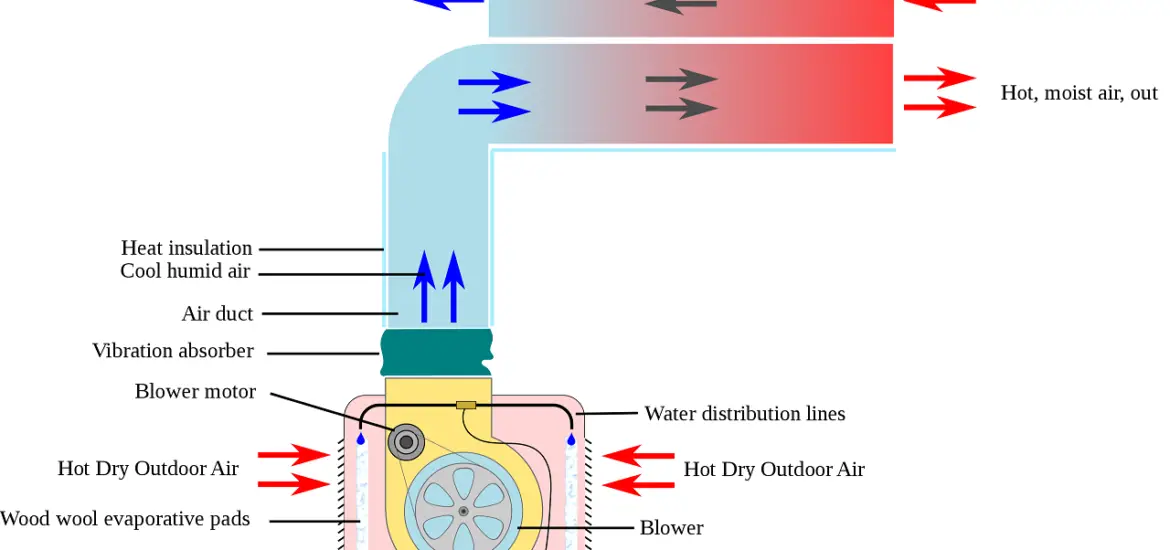Evaporative cooling – ever heard of it? It’s an age-old technique for keeping things cool, but it’s making a major comeback thanks to its energy efficiency and environmental benefits. So, what’s the deal with evaporative cooling?
Well, it’s a method that uses the natural process of evaporation to cool air. It dates back to ancient times and has evolved into a reliable alternative to traditional air conditioning systems. Let’s dive into the basics and explore how this fantastic technology works!

Table of Contents
Applications of Evaporative Cooling
Where can you find evaporative cooling in action? You’ll see it used in:
- Residential cooling – it’s perfect for homes seeking a cost-effective and eco-friendly solution.
- Commercial and industrial cooling – businesses love it for its energy-saving properties and easy maintenance.
- Data centers – these tech hubs need to stay cool, and evaporative cooling helps them do so without breaking the bank.
- Greenhouses – plants thrive in environments with stable temperatures and humidity, which evaporative cooling provides.
How Do Evaporative Coolers Work?
Curious about how evaporative coolers work their magic? It’s all about evaporation, baby. When water evaporates, it absorbs heat from the surrounding air, lowering the temperature. Evaporative coolers capitalize on this natural process by pulling in hot, dry air, passing it through wet cooling pads, and then releasing cool, moist air into the space. Simple, right?
There are a few key components to an evaporative cooler, like the fan, cooling pads, and water supply system. Together, they make this energy-efficient cooling method possible.
Types of Evaporative Coolers
Direct Evaporative Coolers
Direct evaporative coolers are the most common type. They cool air directly by passing it through water-soaked pads. What’s great about these is that they’re energy-efficient and can lower the temperature by up to 20°F! But there’s a catch – they also increase humidity, which can be a bummer in already-humid environments.
Indirect Evaporative Coolers
Indirect evaporative coolers, on the other hand, have a heat exchanger that cools the air without adding moisture. They’re not quite as efficient as direct coolers but work better in humid climates. The trade-off? They’re a bit pricier and more complicated to install.
The Science Behind Evaporative Cooling
Now for the nitty-gritty science stuff. Evaporative cooling relies on the latent heat of vaporization, which is the amount of energy needed to turn liquid water into vapor. Psychrometrics, the study of air and water vapor mixtures, helps us understand how this process affects the air temperature and humidity. Wet-bulb and dry-bulb temperatures are essential concepts here, but don’t worry – you don’t need a degree in meteorology to appreciate the genius of evaporative cooling!
Evaporative Cooler: Features, Benefits, and Considerations
So, why should you consider an evaporative cooler? For starters, they’re energy-efficient, eco-friendly, and suitable for various climates.
Not only do they use up to 75% less energy than traditional air conditioning systems, but they also don’t rely on harmful refrigerants. Plus, they provide better indoor air quality by constantly bringing in fresh air from outside.
But hold on, there’s more! Evaporative coolers come with various features like adjustable fan speeds, built-in filters, and remote controls. Keep in mind, though, that they perform best in dry climates, so if you live in a humid area, you might want to think twice.
Evaporative Cooler Performance Factors
Before you jump on the evaporative cooling bandwagon, there are a few performance factors to consider:
- Cooler size and capacity – make sure it’s right for your space.
- Airflow and ventilation – proper air circulation is key to success.
- Maintenance and water quality – keep your cooler clean and use high-quality water to prevent issues down the road.
Comparing Evaporative Coolers to Traditional Air Conditioning
How do evaporative coolers stack up against traditional air conditioning? In terms of operating principles, they’re pretty different. Traditional AC units use refrigerants and compressors, while evaporative coolers rely on evaporation.
When it comes to energy efficiency, evaporative coolers take the cake. They’re cheaper to install and maintain, too. The only downside? They’re not ideal for humid climates, whereas traditional AC units can handle a wider range of conditions.
Read our other articles on evaporators in refrigeration – Evaporators in Refrigeration: Easy Guide to Understanding Your Fridge’s Unsung Hero
Installation, Maintenance, and Troubleshooting
Installing an evaporative cooler can be a DIY project or done by professionals, depending on your comfort level and expertise. Basic maintenance is essential, like cleaning the pads, checking the water level, and ensuring the fan is working properly.
Common issues include reduced cooling capacity, weird smells, or excessive noise. Thankfully, most problems are easily fixed with a little troubleshooting!
Evaporative Cooler Sizing and Placement
To get the most out of your evaporative cooler, it’s crucial to choose the right size and location. Consider factors like room size, ceiling height, and insulation when determining the best option for your space. Optimal placement typically involves installing the cooler near a window or vent for adequate air exchange.
Winterizing Your Evaporative Cooler
Before winter arrives, don’t forget to winterize your cooler. Drain the water, clean the unit, and cover it to protect it from freezing temperatures. This simple process will ensure your cooler stays in tip-top shape year-round!
Conclusion
Evaporative cooling is an energy-efficient, eco-friendly alternative to traditional air conditioning. Whether you’re a homeowner or a business owner, this cooling method can save you money and reduce your environmental impact. As technology continues to evolve, we can only expect this fantastic cooling solution to become even more efficient and accessible. So, are you ready to chill out with evaporative cooling?